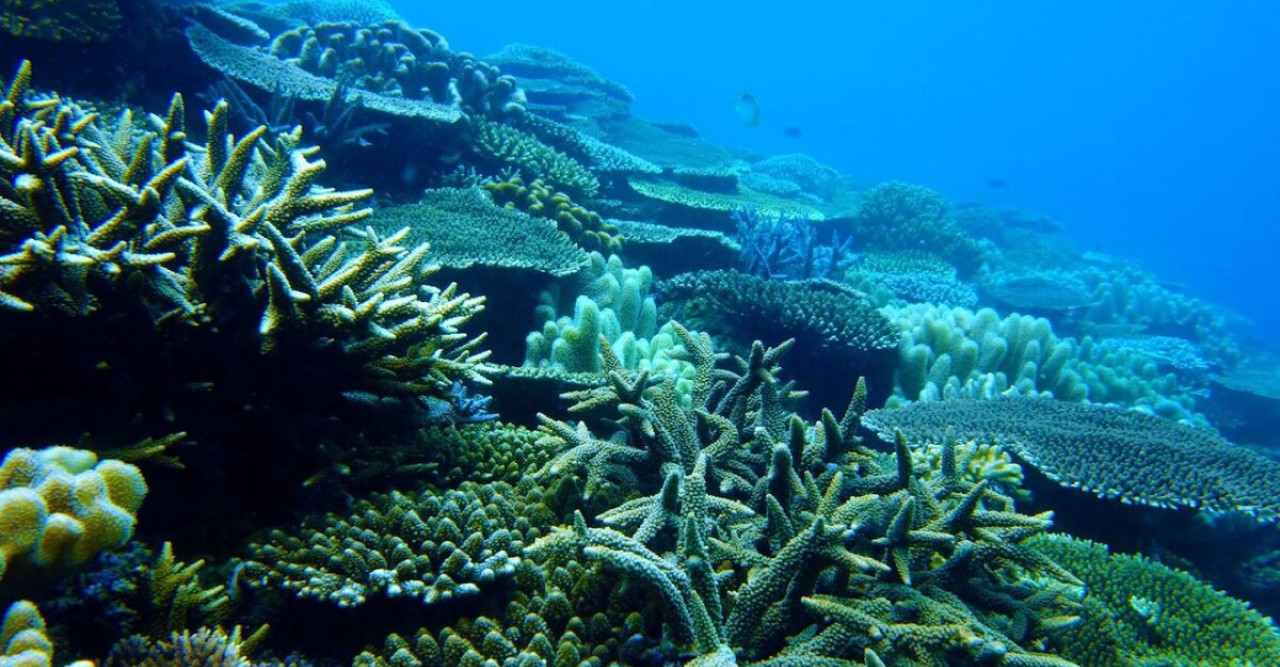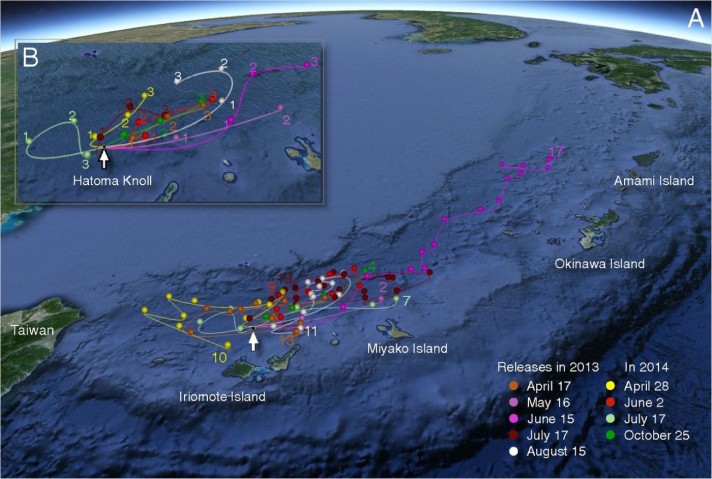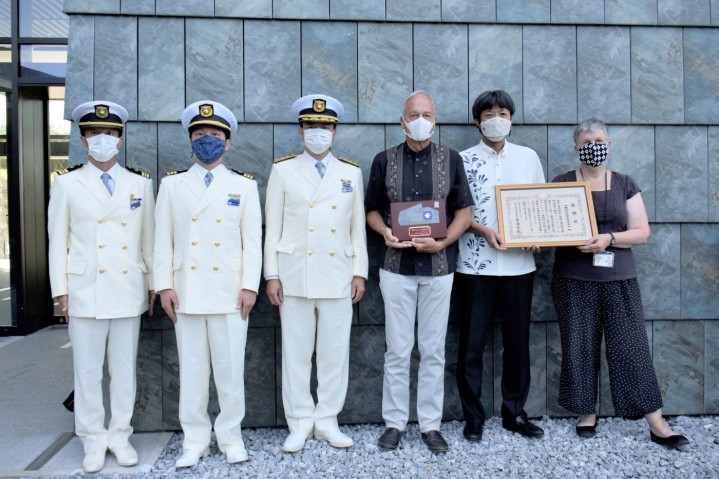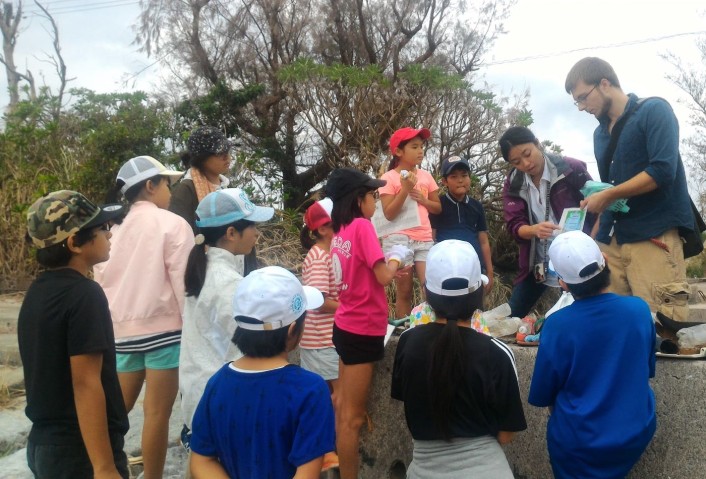Larval Dispersal and Connectivity of Marine Populations

Quantification of marine population connectivity is key to understanding global and longer-term changes of the marine ecosystem. The primary objectives of this project are i) to study dispersal mechanisms of marine species in order to learn how far larvae travel and how quickly they colonize new sites, and ii) to test these predictions of dispersal with recruitment and population genetic data that define the biogeographic characteristics of selected marine species. By understanding the dispersal processes, we hope to contribute to marine conservation planning, e.g., by facilitating optimal design of marine protected areas, which may prevent the collapse of vulnerable ecosystems in Okinawa and even the complete global loss of rare species.

Life Below Water (SDG14) is fundamentally interconnected through ocean currents. Connectivity is one of the fundamental research themes of the Marine Biophysics Unit and is a fundamental process that protects marine environments and species from the damaging effects of human industry and climate change (SDG13). Connectivity is a research theme within the Marine Biophysics Unit that focusses on connectivity and conservation within coastal regions of the Ryukyu archipelago and across areas of open ocean beyond national jurisdiction. Focal environments are coral reefs, mangrove habitats and hydrothermal vents. All of these ecosystems are currently threatened by industrial development and understanding connectivity can inform Responsible Consumption and Production (SDG12). Additionally, the oceanographic processes that sustain connectivity in the ocean are subject to change with the climate. Understanding how connectivity has changed in the past and will change under projected climate scenarios will prepare us for future threats to Life Below Water.
Cooperation Agreement with the Coast Guard
As an application of the developed research tools, the Marine Biophysics Unit has been contributing to i) the improvement of drift prediction accuracy, and ii) sophistication of ocean tide model and ocean current simulation in the sea around Okinawa, through the cooperation agreement with the 11th Regional Coast Guard Headquarters, since March 2012.

Ocean Plastic Dispersal
In collaboration with the OIST ECO (Environmentally Conscious OISTers) club, Marine Biophysics Unit members have taught lessons on how marine debris travels around the world in the ocean and engaged in beach cleans to remove said debris from ocean circulation.

Project Collaborators
Larval Dispersal
Naoya Takeda (Kobe Gakuin University)
Motohiko Kashima (Kobe Gakuin University)
Yusuke Uchiyama (Kobe University)
Sachika Odani (Kobe University)
Yuki Kamidaira (Japan Atomic Energy Agency)
Stephen G. Monismith (Stanford University)
Hiromi Watanabe (Japan Agency for Marine-Earth Science and Technology)
Alexander F. Shchepetkin (University of California, Los Angeles)
James C. McWilliams (University of California, Los Angeles)
Takenori Sasaki (University of Tokyo)
Junichiro Ishibashi (Kyushu University)
Katsunori Fujikura (Japan Agency for Marine-Earth Science and Technology)
Recruiment
Hiromi Kayama Watanabe (Japan Agency for Marine-Earth Science and Technology)
Takenori Sasaki (University of Tokyo)
Hiroyuki Yamamoto (Japan Agency for Marine-Earth Science and Technology)
Nobuo Ueda (OIST)
Masako Nakamura (Tokai University)
Naoki H. Kumagai (University of the Ryukyus)
Kazuhiko Sakai (University of the Ryukyus)
Ken Okaji (Coralquest Inc)
Kei Ogasawara (Okinawa Environment Science Center)
Yoshimi Higa (Onna Village Fisheries Cooperative)
Eiji Yamakawa (Okinawa Environment Science Center)
Population Genetics
Makamas Sutthacheep (Ramkhamhaeng Unuversity)
Zoe Richards (Western Australian Museum)
Put Ang (Chinese University of Hong Kong)
Mareike Sudek (National Marine Sanctuary of American Samoa)
Atsushi Fujimura (University of Guam)
Robert J. Toonen (University of Hawaii)
Alexander S. Mikheyev (OIST)
Evan P. Economo (OIST)
Noriyuki Satoh (OIST)
Akira Iguchi (National Institute of Technology, Okinawa College)
Tomofumi Nagata (Okinawa Prefecture Environment Science Center)
Daisuke Uyeno (Kagoshima University)
Kazuhiko Sakai (University of the Ryukyus)
Hiromi Watanabe (Japan Agency for Marine-Earth Science and Technology)
Fumio Inagaki (Japan Agency for Marine-Earth Science and Technology)
Project Publications
Larval Dispersal
N. Takeda, M. Kashima, S. Odani, Y. Uchiyama, Y. Kamidaira, S. Mitarai, Identification of coral spawn source areas around Sekisei Lagoon for recovery and poleward habitat migration by using a particle-tracking model. Sci. Rep. 11, 6963 (2021).
L. A. Levin, C.-L. Wei, D. C. Dunn, D. J. Amon, O. S. Ashford, W. W. L. Cheung, A. Colaço, C. Dominguez-Carrió, E. G. Escobar, H. R. Harden-Davies, J. C. Drazen, K. Ismail, D. O. B. Jones, D. E. Johnson, J. T. Le, F. Lejzerowicz, S. Mitarai, T. Morato, S. Mulsow, P. V. R. Snelgrove, A. K. Sweetman, M. Yasuhara, Climate change considerations are fundamental to management of deep-sea resource extraction. Glob. Chang. Biol. (2020), doi:10.1111/gcb.15223.
N. S. Vogt‐Vincent, S. Mitarai, A Persistent Kuroshio in the Glacial East China Sea and Implications for Coral Paleobiogeography. Paleoceanography and Paleoclimatology. 35, 897 (2020).
L. S. Mullineaux, A. Metaxas, S. E. Beaulieu, M. Bright, S. Gollner, B. M. Grupe, S. Herrera, J. B. Kellner, L. A. Levin, S. Mitarai, M. G. Neubert, A. M. Thurnherr, V. Tunnicliffe, H. K. Watanabe, Y.-J. Won, Exploring the Ecology of Deep-Sea Hydrothermal Vents in a Metacommunity Framework. Frontiers in Marine Science. 5 (2018), doi:10.3389/fmars.2018.00049.
Y. Uchiyama, S. Odani, M. Kashima, Y. Kamidaira, S. Mitarai, Influences of the Kuroshio on Interisland Remote Connectivity of Corals Across the Nansei Archipelago in the East China Sea. J. Geophys. Res. C: Oceans. 123, 9245–9265 (2018).
S. G. Monismith, M. K. Barkdull, Y. Nunome, S. Mitarai, Transport Between Palau and the Eastern Coral Triangle: Larval Connectivity or Near Misses. Geophys. Res. Lett. 45, 4974–4981 (2018).
Y. Kamidaira, Y. Uchiyama, S. Mitarai, Eddy-induced transport of the Kuroshio warm water around the Ryukyu Islands in the East China Sea. Cont. Shelf Res. 143, 206–218 (2017).
S. Mitarai, H. Watanabe, Y. Nakajima, A. F. Shchepetkin, J. C. McWilliams, Quantifying dispersal from hydrothermal vent fields in the western Pacific Ocean. Proc. Natl. Acad. Sci. U. S. A. 113 (2016), doi:10.1073/pnas.1518395113.
H. Watanabe, T. Yahagi, Y. Nagai, M. H. Seo, S. Kojima, J. I. Ishibashi, H. Yamamoto, K. Fujikura, S. Mitarai, T. Toyofuku, Different thermal preferences for brooding and larval dispersal of two neighboring shrimps in deep-sea hydrothermal vent fields. Mar. Ecol. 37, 1282–1289 (2016).
M. Nakamura, C. Chen, S. Mitarai, Insights into life-history traits of Munidopsis spp. (Anomura: Munidopsidae) from hydrothermal vent fields in the Okinawa Trough, in comparison with the existing data. Deep Sea Res. Part 1 Oceanogr. Res. Pap. 100 (2015), doi:10.1016/j.dsr.2015.02.007.
M. Nakamura, H. Watanabe, T. Sasaki, J. Ishibashi, K. Fujikura, S. Mitarai, Life history traits of Lepetodrilus nux in the Okinawa Trough, based upon gametogenesis, shell size, and genetic variability. Mar. Ecol. Prog. Ser. 505 (2014), doi:10.3354/meps10779.
Recruiment
M. Nakamura, Y. Nakajima, H. K. Watanabe, T. Sasaki, H. Yamamoto, S. Mitarai, Spatial variability in recruitment of benthos near drilling sites in the Iheya North hydrothermal field in the Okinawa Trough. Deep Sea Res. Part I. 135, 65–73 (2018).
Y. Nakajima, P.-S. Chuang, N. Ueda, S. Mitarai, First evidence of asexual recruitment of Pocillopora acuta in Okinawa Island using genotypic identification. PeerJ. 6, e5915 (2018).
M. Nakamura, N. H. Kumagai, K. Sakai, K. Okaji, K. Ogasawara, S. Mitarai, Spatial variability in recruitment of acroporid corals and predatory starfish along the Onna coast, Okinawa, Japan. Mar. Ecol. Prog. Ser. 540, 1–12 (2015).
M. Nakamura, K. Okaji, Y. Higa, E. Yamakawa, S. Mitarai, Spatial and temporal population dynamics of the crown-of-thorns starfish, Acanthaster planci, over a 24-year period along the central west coast of Okinawa Island, Japan. Mar. Biol. 161, 2521–2530 (2014).
Population Genetics
P. H. Wepfer, Y. Nakajima, M. Sutthacheep, V. Z. Radice, Z. Richards, P. Ang, T. Terraneo, M. Sudek, A. Fujimura, R. J. Toonen, A. S. Mikheyev, E. P. Economo, S. Mitarai, Evolutionary biogeography of the reef-building coral genus Galaxea across the Indo-Pacific ocean. Mol. Phylogenet. Evol. 151, 106905 (2020).
Y. Nakajima, P. H. Wepfer, S. Suzuki, Y. Zayasu, C. Shinzato, N. Satoh, S. Mitarai, Microsatellite markers for multiple Pocillopora genetic lineages offer new insights about coral populations. Sci. Rep. 7 (2017), doi:10.1038/s41598-017-06776-x.
Y. Nakajima, A. Nishikawa, A. Iguchi, T. Nagata, D. Uyeno, K. Sakai, S. Mitarai, Elucidating the multiple genetic lineages and population genetic structure of the brooding coral Seriatopora (Scleractinia: Pocilloporidae) in the Ryukyu Archipelago. Coral Reefs. 36, 415–426 (2017).
Y. Nakajima, Y. Zayasu, C. Shinzato, N. Satoh, S. Mitarai, Genetic differentiation and connectivity of morphological types of the broadcast-spawning coral Galaxea fascicularis in the Nansei Islands, Japan. Ecol. Evol. 6 (2016), doi:10.1002/ece3.1981.
Y. Nakajima, C. Shinzato, N. Satoh, S. Mitarai, Novel polymorphic microsatellite markers reveal genetic differentiation between two sympatric types of Galaxea fascicularis. PLoS One. 10, 1–12 (2015).
Y. Nakajima, C. Shinzato, M. Khalturina, H. Watanabe, F. Inagaki, N. Satoh, S. Mitarai, Cross-species, amplifiable microsatellite markers for neoverrucid barnacles from deep-sea hydrothermal vents developed using next-generation sequencing. Int. J. Mol. Sci. 15, 14364–14371 (2014).
Links to Related Resources
Calculating Dispersal from Unique Submarine Hot Spring Ecosystems https://www.oist.jp/news-center/news/2016/3/18/hot-larvae-calculating-dispersal-unique-submarine-hot-spring-ecosystems https://www.hakaimagazine.com/news/epic-migration-along-bottom-sea/
Canon Foundation Research Grant https://www.oist.jp/press-room/news/2011/3/30/dr-mitarai-and-collaborators-receive-canon-foundation-research-grant https://www.oist.jp/news-center/photos/mr-fujio-mitarai-chiarman-and-chief-executive-canon-inc-middle-and-members-oist
Cooperation with the 11th Regional Coast Guard Headquarters https://www.facebook.com/oistedu/posts/were-very-proud-of-the-marine-biophysics-unit-led-by-prof-satoshi-mitarai-who-ye/3689289654435960/ https://www.oist.jp/press-room/news/2012/4/2/oist-concludes-cooperation-agreement-11th-regional-coast-guard-headquarters
Take Action:









